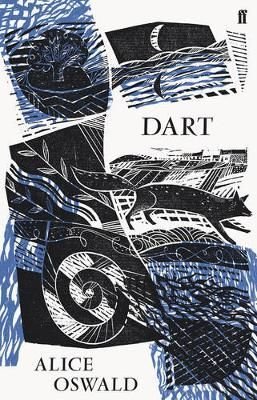
Alice Oswald’s Dart is a book-length poem that maps the flow of the river Dart and all the lives it touches. Although it reveals an intricate network of connectedness, that connectedness does not imply sameness or transparency. In fact the poem’s refrain-like “who’s this” suggests that there is distance to be bridged all the time, a mystery surrounding who’s who and who these different voices are to each other.
Aside from
connectedness the poem is also thematically concerned with time. It plays with
the association between rivers and (linear) time, of which the best example
from the English language is Joseph Conrad’s Heart of Darkness, in which the Congo River and the Thames bear
people back in time, to a primitive past. Dart
too performs this trick of time travel. The poem’s first section features a
walker “An old man, fifty years a mountaineer until [his] heart gave out” (1), who
wanders the wilderness of Dartmoor, where the Dart surfaces “a foal / of a
river," during a kind of primeval dawn, when the earth is still soft and
malleable “your feet sinks right in, it’s like walking on the / bottom of a
lake” (2). The walker, representing mankind, is lonely, humbled by the vastness of
the moor, and afraid of the dark, “[making] a little den of his smells and
small thoughts” (3).
But as time passes the
river widens, encompassing more and more space, not just between its banks, but
also underground and beyond. Its water is “cooped up in moss and moving /
slowly uphill through lean-to trees” (12-11). As the river matures so do its appetites
change. In the section that features the woodman the Dart becomes a flirtatious
waternymph, to whose lascivious gestures and suggestions the woodman remains hilariously
clueless. Even though, in juxtaposition to the formal, rhyming quatrains of the
waternymph, the woodsman’s prose poems are unassuming, there is something very
gentle about the way he describes the woods and how he serves the ecosystem. His
is the exact opposite of the kind of rape of the earth rhetoric that is often presumed
to motivate extractors of natural resources.
The poem ends at the mouth
of the river, with a sealwatcher moving from sea-cave to sea-cave, in whose
moist, tomblike depths he finds “The fur, the hair, the fingernails, the bones”
that one might find in a grave (48). But unlike the cast of human characters that the
poem features, the river never dies, and is born again in “the musky fishy
genital smell / of things not yet actual” (48). It is common parlance that brooks
babble, but Oswald suggests water also speaks itself. Water is a “self-maker” –
it runs from mountain sources to the sea, where it rises as vapour before
raining down again on those same mountains, feeding itself (48). Thus the linearity
we ascribe to rivers, and to time, is undermined in Dart.
In confirmation, the
poem features subtle images of spirals, gyres, and whirlpools. This notion of
time as a spiral or a gyre is connected to the voices of the characters, which
ultimately construct the flow of the river Dart in Oswald’s poem. It is only
through the voices of the people that we move down the river and the sound of
the voices is echoed in the sounds of the river. As the rememberer says: “I
remember when I was a boy / born not more than a mile away from where I am now
/ a whole millennium going by in the form of a wave” (45). The voice is moulded by
the movement of water and the way it remembers follows the natural flow of
water; the voice guides us further towards the sea. It is through this
oral/aural nature of the poem that Oswald constructs the Dart as a material and
cultural landscape. The two are intertwined and flow with each other.
Laura op de Beke and Stephanie König
Works Cited
Oswald, Alice. Dart. Faber and Faber, 2010.
No comments:
Post a Comment